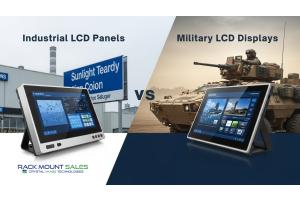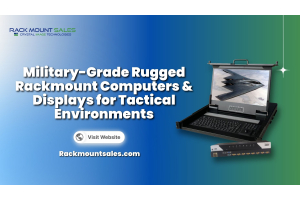How To Choose the Best Industrial Rackmount Monitor
In today's fast-paced industrial landscape, having reliable and efficient equipment is really important for optimizing productivity and ensuring seamless operations. When it comes to industrial environments, a key component that plays a vital role in enhancing efficiency is the industrial rackmount monitor. These specialized monitors are designed to withstand harsh conditions while providing high-performance display capabilities. There are a variety of options available in the market in terms of rackmount monitors. Choosing the best industrial rackmount monitor can be quite a difficult task, but here we aim to provide you with some of the essential factors to consider that suit your specific requirements so that this task can be easy for you.
Here are some of the factors you need to consider while choosing the best industrial rackmount monitor according to your requirement.
- Display Quality:
One of the primary things you need to consider when selecting an industrial rackmount monitor is its display quality. In industrial environments, we need precise and accurate visuals as they are crucial. So, opting for a monitor with excellent image clarity, color accuracy, and high resolution is essential. You need to look for monitors with features such as LED backlighting, wide viewing angles, and high contrast ratios to ensure optimal visual performance even in challenging lighting conditions.
- Durability and Ruggedness:
Industrial environments are often characterized by harsh conditions, including extreme temperatures, vibrations, and exposure to dust, moisture, and chemicals. Therefore, choosing a rugged and durable rackmount monitor is vital. Here, by rugged, we mean that it should be strongly made and able to withstand rough handling. You need to look for monitors that are specifically designed for industrial use, with features such as rugged metal enclosures, reinforced glass, and IP-rated protection against dust and water. Additionally, opt for monitors that comply with industry standards such as MIL-STD-810 for shock and vibration resistance.
- Size and Mounting Options:
Another thing to consider is the available space in your industrial setup. Select a rackmount monitor that fits appropriately. Industrial rackmount monitors come in various sizes, ranging from compact displays to larger screens. Assess your specific requirements and choose a size that provides optimal visibility without obstructing other critical equipment. Moreover, consider the mounting options available for the rackmount monitor. Make sure that the monitor is compatible with the rack system in your industrial environment. Some of the common mounting options are VESA mounts, rack slide rails, and front-panel mounting. Each has its own feature select the one that fits your requirement.
- Connectivity and Compatibility:
Efficient connectivity is essential for seamless integration with other industrial systems and equipment. Look for rackmount monitors that offer a wide range of input/output options such as VGA, DVI, HDMI, USB, and serial ports. This ensures compatibility with various devices and allows for flexible connectivity. Moreover, consider the compatibility of the rackmount monitor with your existing industrial systems and software. Verify that the monitor supports the required operating systems and protocols to ensure smooth integration and functionality.
- Touchscreen Capabilities:
In certain industrial applications, touchscreen functionality can significantly enhance user interaction and efficiency. Assess whether your specific requirements demand a touchscreen rackmount monitor. If so, ensure that the monitor offers a responsive and durable touchscreen interface that can withstand frequent usage and harsh industrial conditions.
- Environmental Considerations:
Industrial environments often have specific environmental requirements that need to be met. For instance, some industries might require rackmount monitors with extended temperature ranges to operate reliably in extreme heat or cold. Others may require monitors with anti-glare coatings to minimize reflections and ensure clear visibility in brightly lit areas. Consider your industry-specific environmental conditions and choose a rackmount monitor that is built to withstand and perform optimally in those conditions.
- Customization and Additional Features:
Evaluate whether your industrial application demands any additional features or customizations. Some rackmount monitor manufacturers offer customization options such as protective shields, enhanced sunlight readability, or specialized mounting brackets to meet unique requirements. Assess the availability of such options and ensure they align with your specific needs.
- Brand Reputation and Support:
When investing in industrial equipment, it is crucial to consider the reputation and support offered by the manufacturer. Opt for established brands that have a track record of delivering high-quality industrial rackmount monitors. Research the manufacturer's reputation, read customer reviews, and check if they offer reliable customer support, warranties, and technical assistance. Choosing a reputable brand ensures that you receive a durable and dependable product backed by excellent after-sales service.
- Cost-Effectiveness:
While it's important to prioritize quality and durability, it's equally essential to consider the cost-effectiveness of the rackmount monitor. Set a budget based on your requirements and research the market for options that offer the best balance between performance, features, and price. Remember that investing in a high-quality monitor upfront can save you money in the long run by minimizing downtime and maintenance costs.
- Future Expansion and Upgradability:
Industrial environments are dynamic, and your needs may evolve over time. Consider the scalability and upgradability of the rackmount monitor. Ensure that the monitor allows for future expansions such as additional input/output ports or compatibility with emerging technologies. Choosing a monitor with room for growth ensures that your investment remains relevant and adaptable to future requirements.
- Regulatory Compliance:
Depending on your industry, certain regulations and standards may need to be met. Ensure that the rackmount monitor complies with relevant regulations and certifications such as CE, FCC, RoHS, or UL. This ensures that the monitor meets safety standards and operates reliably within specified parameters.
- Seek Expert Advice:
If you are unsure about the specific requirements of your industrial setup or finding the best rackmount monitor, seek advice from industry experts or consultants. They can provide valuable insights and recommendations based on their experience and knowledge. Collaborating with professionals can help you make an informed decision and select the most suitable monitor for your unique needs.
Conclusion:
Choosing the best industrial rackmount monitor is a critical decision that can significantly impact the efficiency and productivity of your industrial operations. By considering factors such as display quality, durability, size, connectivity, touchscreen capabilities, environmental considerations, customization options, brand reputation, cost-effectiveness, future expansion, regulatory compliance, and seeking expert advice, you can make a well-informed decision.
Remember, each industrial environment is unique, so take the time to assess your specific requirements and match them with the features and specifications offered by different rackmount monitors. Investing in a high-quality and reliable industrial rackmount monitor will not only enhance the visual experience but also contribute to seamless operations and improved productivity in your industrial setting.











